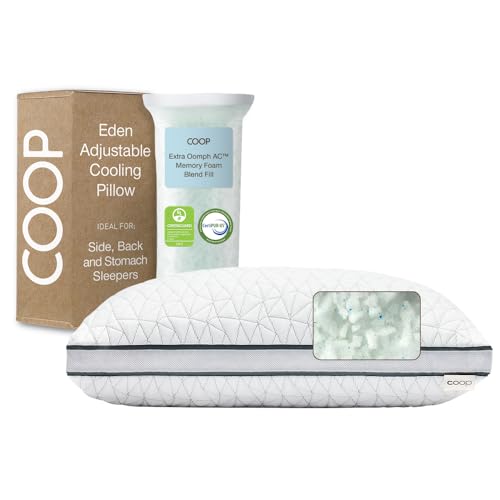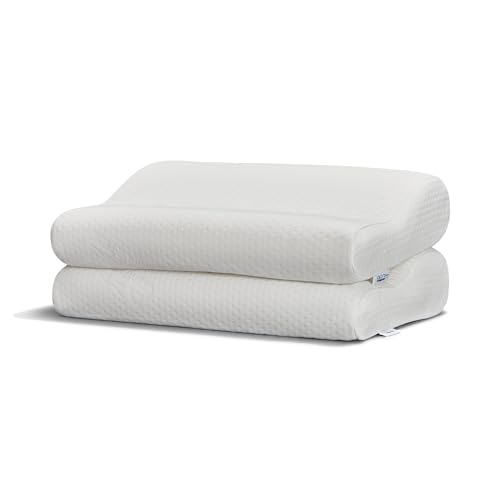Disclosure
This website is a participant in the Amazon Services LLC Associates Program, an affiliate advertising program designed to provide a means for us to earn fees by linking to Amazon.com and affiliated sites.
The best pillow for back sleepers is one that offers medium-firm support and proper neck alignment—such as a contour memory-foam pillow designed to cradle the head and maintain spine neutrality. Back sleepers need just enough loft to fill the gap between the neck and mattress without tilting the head too far forward or letting it sink too low.
Did you know that nearly 16% of adults sleep primarily on their backs? While this position can reduce wrinkles and ease shoulder strain, using the wrong pillow can lead to morning stiffness, headaches, and lower back pain. Imagine waking up free of aches, with your spine naturally aligned and your muscles fully relaxed—that’s precisely what the right pillow can deliver.
In this guide, we’ll explore top-rated pillows built for back sleepers, explain what to look for in materials and loft, and share expert-backed tips to help you choose the perfect match. Say goodbye to restless nights and hello to rejuvenating sleep!
Best Pillows for Back Sleepers
Here are three top pillows specially designed to support back sleepers, each chosen for their unique benefits and customer satisfaction:
Coop Home Goods Eden Pillow
This adjustable memory foam pillow allows you to customize the loft and firmness, providing perfect neck support for back sleepers seeking personalized comfort.
- Enhanced Breathability for Better Sleep: Designed with a blend of soft,…
- Fully Adjustable, You Are in Control: Experiencing discomfort, snoring or…
- Is Your Pillow Green Guard Gold Certified?: Our Coop Home Goods Eden Pillows…
Tempur-Pedic TEMPUR-Neck Pillow
Known for its ergonomic design, this pillow contours to the natural curve of your neck, offering firm support that keeps your spine aligned throughout the night.
- Helps relieve aches and pains: TEMPUR-Material precisely adapts to your head,…
- TEMPUR-Material: Formed TEMPUR-Material in an extra-firm feel maintains its…
- Premium Cover: A [100%] polyester knit and hypoallergenic cover is removable and…
Snuggle-Pedic Ultra-Luxury Bamboo Pillow
Made with shredded memory foam and a breathable bamboo cover, this pillow offers both support and cooling, ideal for back sleepers who tend to overheat.
What Makes a Pillow Ideal for Back Sleepers?
Choosing the right pillow as a back sleeper is essential to maintain proper spinal alignment and avoid discomfort. The ideal pillow should support the natural curve of your neck while keeping your head aligned with your spine.
Back sleepers generally need a pillow with medium loft—meaning it should be thick enough to fill the space between the mattress and neck but not so high that it pushes the head forward. Too thick, and you risk neck strain; too thin, and your head will tilt backward.
Material plays a key role in comfort and support. Memory foam and latex pillows often excel because they contour to your neck and head shape, providing targeted support that prevents pressure points. Additionally, adjustable pillows with removable fill let you customize firmness and loft, accommodating different body types.
Breathability is also crucial. Since back sleepers lie flat, a pillow with good airflow helps regulate temperature, ensuring you stay cool and comfortable all night.
Key factors to consider for back sleeper pillows:
- Medium loft (about 3 to 5 inches)
- Contouring material like memory foam or latex
- Adjustable fill for personalized support
- Breathable and cooling fabric covers
Benefits of Using the Right Pillow for Back Sleepers
Using the right pillow when you sleep on your back can make a significant difference in your overall sleep quality and health. Proper neck and spine alignment reduces the risk of waking up with pain or stiffness. This simple change can improve your day-to-day comfort and even your long-term well-being.
A well-chosen pillow helps evenly distribute your head’s weight, reducing pressure on sensitive areas like the neck and shoulders. This can prevent headaches and tension buildup. Moreover, it supports natural breathing patterns by keeping your airways open, potentially reducing snoring and improving oxygen flow.
Back sleepers who use supportive pillows often notice improved muscle relaxation. When your head and neck are supported, your muscles don’t have to work overtime to hold your posture. This leads to deeper, more restorative sleep cycles.
Additional benefits include:
- Decreased neck and upper back pain
- Reduced risk of developing poor posture
- Enhanced sleep comfort and duration
- Improved spinal health over time
Choosing the right pillow isn’t just about comfort—it’s an investment in your health that pays off every morning.
How to Choose the Perfect Pillow Material for Back Sleepers
Selecting the right pillow material is crucial for comfort, support, and durability. For back sleepers, the material affects how well the pillow maintains shape and supports the neck’s natural curve throughout the night.
Memory Foam is a top choice because it molds to your head and neck, providing customized support that relieves pressure points. It’s excellent for those who want a firm but comfortable feel. However, some memory foam pillows can retain heat, so look for those with cooling gel or breathable covers.
Latex pillows are naturally resilient and bouncy. They provide consistent support without the sinking feeling some memory foam users dislike. Latex is also hypoallergenic and resistant to dust mites, making it ideal for allergy sufferers. It tends to be cooler than memory foam, adding comfort for warmer sleepers.
Feather and Down pillows offer softness and good loft but may lack the structured support that back sleepers need. They can be adjusted by adding or removing feathers but might require frequent fluffing.
Adjustable Pillows combining shredded memory foam or latex allow you to customize loft and firmness, which is perfect for finding your ideal neck support.
When choosing pillow materials, consider:
- Your personal comfort preference (firm vs. soft)
- Any allergies or sensitivities
- Temperature regulation needs
- Durability and maintenance requirements
Pillow Loft and Its Importance for Back Sleepers
Pillow loft refers to the height or thickness of the pillow, and it plays a crucial role in ensuring proper neck and spine alignment for back sleepers. The right loft fills the space between your head and the mattress, preventing your head from tilting too far backward or forward.
For most back sleepers, a medium loft pillow—typically between 3 to 5 inches—is ideal. This height supports the natural curve of your neck without causing strain. Too high a loft can push your head forward, creating neck tension, while too low a loft can allow your head to sink backward, leading to discomfort.
Adjustable pillows offer a valuable solution for finding your perfect loft, allowing you to add or remove filling until you achieve optimal support.
Here’s why pillow loft matters:
- Maintains spinal neutrality by supporting natural neck curvature
- Prevents muscle strain and tension headaches
- Enhances overall sleep comfort and reduces tossing and turning
- Helps maintain good posture, even during sleep
Back sleepers should always test pillow loft alongside material and firmness to ensure a harmonious combination that supports restful sleep.
Pillow Maintenance and Care Tips for Longevity and Hygiene
Taking good care of your pillow not only extends its lifespan but also helps maintain a clean, healthy sleep environment—especially important for back sleepers who rely heavily on proper neck support.
Most pillows, especially memory foam and latex, come with removable, washable covers. Regularly washing these covers helps reduce allergens like dust mites, which can disrupt your sleep quality.
Here are essential maintenance tips:
- Fluff your pillow daily to maintain its shape and prevent flattening.
- Air out your pillow weekly by placing it in fresh air or sunlight to reduce moisture and odors.
- Wash pillowcases and covers weekly in hot water to kill allergens.
- Follow manufacturer instructions for cleaning memory foam or latex pillows, as some require spot cleaning or special care.
- Replace your pillow every 1-2 years to ensure optimal support and hygiene.
Proper pillow care preserves supportiveness, keeping your neck and spine aligned night after night. Cleanliness also contributes to better breathing and overall sleep quality.
Conclusion
Choosing the best pillow for back sleepers is all about finding the right balance of support, loft, and comfort. A medium loft pillow made from contouring materials like memory foam or latex can maintain proper neck alignment and reduce pressure points, leading to restful, pain-free sleep. Adjustable pillows offer added customization, helping you tailor support to your unique needs.
Remember, the right pillow isn’t just a comfort accessory—it’s an essential part of healthy sleep posture that can improve your overall wellbeing. Pair your pillow choice with good maintenance habits to keep it fresh, supportive, and durable.
For further reading, explore articles on “Best Pillows for Neck Pain” and “How to Improve Sleep Posture” to deepen your knowledge and enhance your sleep experience.
Frequently Asked Questions About Which Pillow is Best for Back Sleepers
What type of pillow loft is best for back sleepers?
Back sleepers generally benefit from a medium loft pillow, usually between 3 to 5 inches. This height supports the natural curve of your neck without pushing your head too far forward or letting it sink too low, promoting proper spinal alignment.
Are memory foam pillows good for back sleepers?
Yes, memory foam pillows are excellent for back sleepers because they contour to the shape of your head and neck, providing customized support that reduces pressure points and maintains alignment throughout the night.
Can I use a feather pillow if I sleep on my back?
Feather pillows offer softness and adjustable loft but may lack firm, consistent support. Back sleepers often find them less ideal unless they can fluff and adjust them frequently to maintain proper neck support.
How often should I replace my pillow?
It’s recommended to replace pillows every 1 to 2 years. Over time, pillows lose their shape and support, which can lead to neck pain and disrupted sleep, especially for back sleepers who rely heavily on proper alignment.
Does pillow material affect temperature during sleep?
Absolutely. Materials like memory foam can retain heat, but many modern pillows include cooling gels or breathable covers to regulate temperature. Latex and shredded memory foam pillows tend to offer better airflow, making them ideal for back sleepers who overheat.



